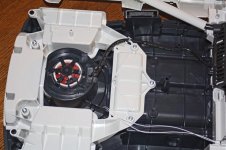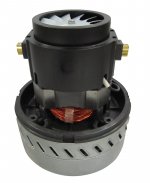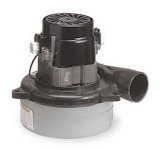I am specifically wondering about the new CT wings. i think these things are a great idea, but are the CT vacs designed to run against the constant load that will be imparted by the CT wings? I have to assume yes because festool wouldn't design a product that will kill their vacs, but could someone please expound on this for me?
You are using an out of date browser. It may not display this or other websites correctly.
You should upgrade or use an alternative browser.
You should upgrade or use an alternative browser.
Can CT Vacs safely run under blocked suction?
- Thread starter Nick2cd
- Start date
- Joined
- Jan 22, 2007
- Messages
- 1,641
Most people hear the sound of a vacuum cleaner get louder when the inlet is blocked and assume it is because the motor is under load. It is actually the opposite. The motor is under its greatest load when the airflow is maximum and unrestricted. So when the CT wings are used the motor is not working very hard at all.
Another potential concern for using the CT wings would be motor cooling. However, the CT vacs all have a separate air channel and blower impeller for cooling the motor. Vacuumed air does not pass through the motor.
Another potential concern for using the CT wings would be motor cooling. However, the CT vacs all have a separate air channel and blower impeller for cooling the motor. Vacuumed air does not pass through the motor.
Rick Christopherson said:Most people hear the sound of a vacuum cleaner get louder when the inlet is blocked and assume it is because the motor is under load. It is actually the opposite. The motor is under its greatest load when the airflow is maximum and unrestricted. So when the CT wings are used the motor is not working very hard at all.
Another potential concern for using the CT wings would be motor cooling. However, the CT vacs all have a separate air channel and blower impeller for cooling the motor. Vacuumed air does not pass through the motor.
what a sigh of relief. thanks for the info!
AlexThePalex
Member
- Joined
- Nov 12, 2008
- Messages
- 7,808
Rick Christopherson said:Most people hear the sound of a vacuum cleaner get louder when the inlet is blocked and assume it is because the motor is under load. It is actually the opposite. The motor is under its greatest load when the airflow is maximum and unrestricted. So when the CT wings are used the motor is not working very hard at all.
Then why exactly does the motor sound become louder and higher pitched?
- Joined
- Jan 22, 2007
- Messages
- 1,641
The motor sounds that way because its running faster because it is completely unloaded. When the inlet is blocked, there is no air inside the impeller to have to move.
- Joined
- Jan 22, 2007
- Messages
- 1,641
bror said:It would be nice to get an official Festool opinion regarding this question.
I don't understand. What's the contention?
The only possible unknown is whether the CT motor will properly cool itself without using airflow from the vacuum hose. I confirmed that for myself last week by disassembling a new CT36E. I also re-confirmed it directly with the product manager at Festool earlier this week.
Because I forgot to take a picture last week, I just took it back apart to take the picture shown below. The reddish part on top of the motor is a cooling fan which draws air in from in front of the vac, passes through the electronics compartment, and then through the motor to cool it.
Some vacuums aren't designed this way, and they can overheat if the vacuum inlet is blocked because they use the main airflow to also cool the motor. Festool CT-vacs are designed to have a completely separate cooling airflow for the motor that does not rely on the main vacuum airflow.
[attachimg=1]
If the point of contention is whether a vacuum motor is unloaded when the inlet is blocked, maybe this analogy will make it easier to understand.
When the inlet is blocked, there is less air inside the impeller that needs to be moved around. A similar situation could be seen with a motorboat propeller. When the boat is in the water, the propeller has to push the water toward the back of the boat to move forward. However, it should be pretty self evident that if the propeller is taken out of the water, the motor doesn't need to work as hard. So the motor would then race, just like the vacuum motor will race when it isn't pushing any air.
Attachments
bror
Member
- Joined
- Jul 10, 2011
- Messages
- 85
Thanks for making that clear Rick.
I started a thread about my home made vacuum devises.
http://festoolownersgroup.com/festool-jigs-tool-enhancements/no-ct-wings-for-me-i-guess/
In responses it was suggested that the use of my designs could possibly result in harming the vacuum. If this could be the case I would feel obliged to modify my original post to mention this. That's all.
Rogier
I started a thread about my home made vacuum devises.
http://festoolownersgroup.com/festool-jigs-tool-enhancements/no-ct-wings-for-me-i-guess/
In responses it was suggested that the use of my designs could possibly result in harming the vacuum. If this could be the case I would feel obliged to modify my original post to mention this. That's all.
Rogier
- Joined
- Jan 22, 2007
- Messages
- 1,641
bror said:Thanks for making that clear Rick.
I started a thread about my home made vacuum devises. In responses it was suggested that the use of my designs
could possibly result in harming the vacuum. If this could be the case I would feel obliged to modify my original post to mention this. That's all.
Rogier
I think I may have seen that thread, but I didn't comment at the time because I could not as yet confirm the separate cooling path for the motor. Nevertheless, it was due to a recent discussion here at the FOG that prompted me to investigate the motor cooling when I obtained a new CT36E vac a couple weeks ago.
Edit: Oh, you added a link to your posting for that discussion. So yes, now that I see it, it was your thread that prompted me to look into this.
Brice Burrell
Member
- Joined
- Mar 13, 2007
- Messages
- 7,386
Its funny, I've been saying the same thing as Rick has for years on here, and I have gotten replies of doubt as well.
As for the separate cooling fan, there still seems to be the lingering misunderstanding about the fabled "bypass cooling fan" feature that you hear people mentioning about the Fein vacs. I believe Fein promoted a bypass feature that lead people to believe that somehow if the vac inlet became blocked the airflow would bypass normal channels to cool the motor. I don't own a Fein vac but I'm fairly sure this isn't the case at all. I'd guess Fein has a cooling fan on top of the motor. In fact, even the cheapest of cheap shop vacs have a separate cooling fan. Pretty much every universal motor you'll find has a cooling fan on the top.
Take a look at the first picture below, this is what pretty much every shop vac motor loos like. The inlet is at the bottom of the motor, you can't see in this picture. The small fins going around the motor near the bottom is the exhaust. You'll notice the fan on top of the motor, this is purely for cooling the motor. The airflow from the vacuum doesn't cool the motor at all on almost all shop type vacs. The Festool and Fein vac motors probably look more like the second pic with the ported exhaust.
Now the question that is still present about will a vac with the inlet blocked or not moving air (the load removed) is whether the increased speed that motor will run at will overheat the bearings? I'm not going to touch that one.....
As for the separate cooling fan, there still seems to be the lingering misunderstanding about the fabled "bypass cooling fan" feature that you hear people mentioning about the Fein vacs. I believe Fein promoted a bypass feature that lead people to believe that somehow if the vac inlet became blocked the airflow would bypass normal channels to cool the motor. I don't own a Fein vac but I'm fairly sure this isn't the case at all. I'd guess Fein has a cooling fan on top of the motor. In fact, even the cheapest of cheap shop vacs have a separate cooling fan. Pretty much every universal motor you'll find has a cooling fan on the top.
Take a look at the first picture below, this is what pretty much every shop vac motor loos like. The inlet is at the bottom of the motor, you can't see in this picture. The small fins going around the motor near the bottom is the exhaust. You'll notice the fan on top of the motor, this is purely for cooling the motor. The airflow from the vacuum doesn't cool the motor at all on almost all shop type vacs. The Festool and Fein vac motors probably look more like the second pic with the ported exhaust.
Now the question that is still present about will a vac with the inlet blocked or not moving air (the load removed) is whether the increased speed that motor will run at will overheat the bearings? I'm not going to touch that one.....
Attachments
AlexThePalex
Member
- Joined
- Nov 12, 2008
- Messages
- 7,808
Ricks' explanation makes sense to me, so I'm convinced. Was thinking about the problem with the increased speed too, just like Brice, but I think industrial motors like in Festool vacs won't have a problem with it.
- Joined
- Nov 3, 2007
- Messages
- 5,133
In Bror's thread, I compared it to a router cutting big chunks or dwelling, stating that it works a lot harder cutting big chunks.
I like the boat propeller analogy better - except... If you take an outboard motor out of the water, it WILL overheat.
Tom
I like the boat propeller analogy better - except... If you take an outboard motor out of the water, it WILL overheat.
Tom
Cheese
Member
Rick Christopherson said:The reddish part on top of the motor is a cooling fan which draws air in from in front of the vac, passes through the electronics compartment, and then through the motor to cool it.
Some vacuums aren't designed this way, and they can overheat if the vacuum inlet is blocked because they use the main airflow to also cool the motor. Festool CT-vacs are designed to have a completely separate cooling airflow for the motor that does not rely on the main vacuum airflow.
Hey [member=57769]TylerC[/member], just curious if this also applies to the new CT SYS vac?
GarryMartin
Member
- Joined
- Jun 11, 2011
- Messages
- 1,975
Cheese said:Hey [member=57769]TylerC[/member], just curious if this also applies to the new CT SYS vac?
Peter Halle said:There is an automatic air bypass system that activates if the bag is clogged. It does have overheat protection also.
John Stevens
Member
- Joined
- Jan 16, 2007
- Messages
- 815
Rick Christopherson said:If the point of contention is whether a vacuum motor is unloaded when the inlet is blocked, maybe this analogy will make it easier to understand.
I'm not sure I'd characterize it as "contention" as much as difficulty in understanding. Before I read this thread tonight my son was showing me a circuit he made with a couple of electric motors in an electronics hobby kit he has. He had me measure amps and volts in the circuit as he put loads on the motors and sure enough, both dropped as he loaded the motors, and both rose as he removed the loads. I still don't understand why that is, despite your good analogy, but I believe what I saw on the multi-meter tonight.
---John
The CT SYS is a little different than the others in this regard. First, all the other CT vacuums do have bypass cooling, which is essentially a secondary fan that pulls air through the motor area, which keeps the vacuum cool if it were to clog.
In the case of the CT SYS, there is a slightly different set-up. If the hose becomes clogged, a bypass valve will open. You can actually hear it. This still provides the protection from overheating, it is just a different design than the standard CT.
In the case of the CT SYS, there is a slightly different set-up. If the hose becomes clogged, a bypass valve will open. You can actually hear it. This still provides the protection from overheating, it is just a different design than the standard CT.
Cheese
Member
Thanks to [member=11629]GarryMartin[/member] and [member=57769]TylerC[/member] for the answers... [smile], so then I'm curious if when the bypass valve is actuated is that a throttled (variable) action or does the valve just open all the way at which time you'd lose the vacuum in the hose?
I'm thinking along the line of a hand vacuum lifter used to lift blue stone patio squares. If the bypass valve opens fully and you lose vacuum...you'll also drop the stone.
I'm thinking along the line of a hand vacuum lifter used to lift blue stone patio squares. If the bypass valve opens fully and you lose vacuum...you'll also drop the stone.
Similar threads
- Replies
- 5
- Views
- 1K
- Replies
- 6
- Views
- 281K
- Replies
- 19
- Views
- 6K
- Replies
- 12
- Views
- 3K
- Replies
- 1
- Views
- 2K



